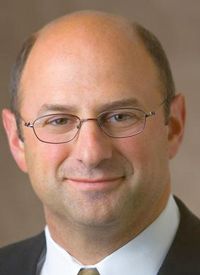Brentuximab Vedotin Submitted for FDA Approval as Treatment for Hodgkin Lymphoma
Brentuximab vedotin (Adcetris) has been submitted for FDA approval in combination with Adriamycin, vinblastine, dacarbazine for the frontline treatment of patients with advanced classical Hodgkin lymphoma. Seattle Genetics, the company developing brentuximab vedotin, recently announced the submission of a supplemental new drug application for the CD30-targeted antibody-drug conjugate.
Clay Siegall, PhD

Clay Siegall, PhD
Brentuximab vedotin (Adcetris) has been submitted for FDA approval in combination with Adriamycin, vinblastine, dacarbazine (AVD) for the frontline treatment of patients with advanced classical Hodgkin lymphoma. Seattle Genetics, the company developing brentuximab vedotin, recently announced the submission of a supplemental new drug application for the CD30-targeted antibody-drug conjugate.
The application was based on findings from the phase III ECHELON-1 trial, which demonstrated superior progression-free survival (PFS) with brentuximab vedotin plus AVD compared with standard ABVD (AVD plus bleomycin). In the study, the brentuximab vedotin regimen reduced the risk of progression, death, or initiation of new therapy by 23% compared with ABVD. The 2-year modified PFS rate was 82.1% with brentuximab vedotin compared with 77.25% for standard chemotherapy (HR, 0.77; P = .035).
Full findings from the ECHELON-1 study have not yet been released and are scheduled to be presented during the 2017 ASH Annual Meeting. Although exact numbers are not yet available, Seattle Genetics noted that a statistical trend favoring the brentuximab vedotin arm was also seen for overall survival.
In October, Seattle Genetics announced that brentuximab vedotin had received a breakthrough therapy designation from the FDA as a frontline treatment for Hodgkin lymphoma, based on findings from the ECHELON-1 study. The trial was conducted under a special protocol assessment agreement with the FDA, which suggests that findings from the study will be sufficient for approval. Under the Prescription Drug User Fee Act, the FDA is scheduled to review the application within 60 days, at which point the agency will assign a review deadline.
“Results from the ECHELON-1 study demonstrated superior activity of an Adcetris-containing regimen over standard of care, and resulted in FDA breakthrough therapy designation for Adcetris in combination with chemotherapy for frontline advanced classical Hodgkin lymphoma," Clay Siegall, PhD, president and chief executive officer of Seattle Genetics, said in a statement. "We believe these data represent a significant advance for the patient and physician community and look forward to working with the FDA to complete the review of this new treatment regimen as quickly as possible.”
The phase III ECHELON-1 trial enrolled 1334 patients with stage III/IV classical Hodgkin lymphoma. All patients had not received prior treatment with systemic chemotherapy or radiotherapy and had an ECOG performance status of ≤2. In both arms, treatment was given on days 1 and 15 of a 28-day cycle. Doxorubicin was given at 25 mg/m2, vinblastine was administered at 6 mg/m2, and patients received dacarbazine at 375 mg/m2. In the investigational arm, brentuximab vedotin was administered at 1.2 mg/kg and in the control group bleomycin was administered at 10 units/m2.
The primary endpoint of the study was modified PFS by independent review committee. Under the modified criteria, PFS was defined as time to progression, death, or receipt of additional therapy for those not in complete response. The modified endpoint was meant to eliminate the potential impact of consolidation treatment with chemotherapy or radiotherapy. Secondary endpoints included overall survival and safety.
In a prior phase I study exploring the frontline regimen of brentuximab vedotin and AVD, 24 of 25 patients (96%) experienced a complete response with the combination. In long-term findings, the 3-year failure-free survival rate was 96% and the overall survival rate at 3 years was 100%. The most common grade ≥3 adverse events were neutropenia (77%), anemia (12%), febrile neutropenia (8%), and syncope (8%).
“There have been no new treatment advances for frontline Hodgkin lymphoma in more than 40 years,” said Siegall. “Up to 30% of the patients diagnosed with advanced disease will experience disease progression after frontline treatment with the current standard of care chemotherapy regimen, representing a significant unmet need to improve the treatment outcome of these patients who are often young adults.”
Brentuximab vedotin is currently approved for patients with classical Hodgkin lymphoma following autologous hematopoietic stem cell transplantation (HSCT) or after failure of 2 prior regimens, if not candidates for HSCT. The agent is also approved as consolidation therapy for patients with Hodgkin lymphoma at high risk of relapse or progression following autologous HSCT.
Reference:
Connors JM, Ansell S, Park SI, et al. Brentuximab vedotin combined with ABVD or AVD for patients with newly diagnosed advanced stage Hodgkin lymphoma: long term outcomes.Blood. 2014; 124:292.
Telehealth Continues to Show Importance Post COVID-19 in Rare Diseases
December 29th 2024In an interview with Peers & Perspectives in Oncology, Doris M. Ponce, MD, MS, a bone marrow transplant specialist, discussed how telehealth made a significant impact on patients with rare diseases receiving medical care and why the rules from the COVID-19 era should be brought back to continue helping these patients.
Read More
Examining the Non-Hodgkin Lymphoma Treatment Paradigm
July 15th 2022In season 3, episode 6 of Targeted Talks, Yazan Samhouri, MD, discusses the exciting new agents for the treatment of non-Hodgkin lymphoma, the clinical trials that support their use, and hopes for the future of treatment.
Listen
Epcoritamab Delivers Durable Responses in Anthracycline-Ineligible LBCL
December 12th 2024Fixed-duration, subcutaneous epcoritamab-bysp achieved durable responses with a manageable safety profile in older patients with newly diagnosed large B-cell lymphoma who are not candidates for anthracycline-based therapy.
Read More